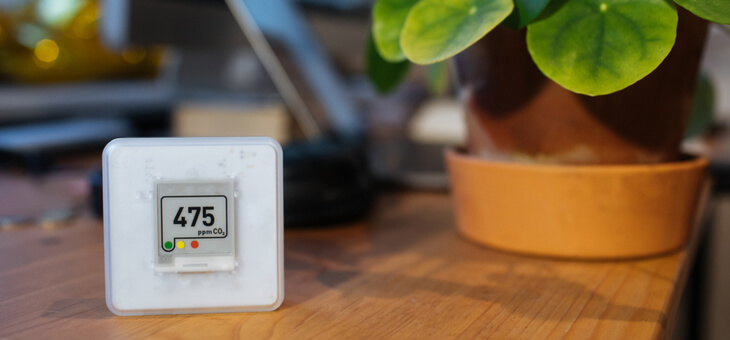Carbon dioxide monitors are emerging as the latest line of defence against COVID, with sales of the devices on the rise.
As our understanding of how COVID spreads increases, it has become apparent that aerosol transmission is a culprit. One of the keys to reducing the risk of such transmission is a well-ventilated space.
Read: Calculating the cost of cleaning the air we breathe
Outdoor venues are recommended for large gatherings for that very reason. Even on a still day, air disperses far more quickly outside than in a confined space. But where it is necessary to meet indoors, good ventilation is paramount, and measuring the levels of carbon dioxide (CO2) is a useful way of monitoring ventilation efficiency.
What is aerosol transmission?
In May last year, under pressure from experts, the World Health Organization acknowledged that COVID could be transmitted via airborne aerosols and not just larger droplets. Size is the key difference between the two, although the accepted boundary between the two is the subject of ongoing discussions. What is clear is that aerosols are very, very small, with definitions varying from below 5µm to as high as 100µm. The Greek letter µ (‘mu’) represents ‘micro’ in the metric measurement system, so 1µm equates to one micrometre, which is one thousandth of one millimetre.
As droplets are generally much larger than aerosols, they are more likely to fall to a surface far sooner, and within a short distance of leaving the mouth or nose. Being far lighter, aerosol particles can be suspended in the air for much longer, increasing the chances of being inhaled. In some circles, the identification of aerosol transmission changed the focus of prevention from ‘close contact’ to improving ventilation and tools such as air filters.
The Victorian government has bought 51,000 Samsung air purifiers and has promised to deliver these to schools by the start of the school year. The education department is also recommending schools adopt measures to increase ventilation via manual methods such as opening windows or setting existing air conditioner recirculation systems to use 100 per cent outdoor air.
What is a CO2 monitor and how can it help you stay safe?
CO2 monitors measure the amount of carbon dioxide in the area, with a figure 800 parts per million or more considered unsafe. Higher figures are usually an indicator of poor ventilation, and monitors can be adjusted to set off an alarm when CO2 reaches an unsafe level. Indoor shoppers or café patrons can then make an informed decision on whether it is best to leave the premises or move outside.
Read: Can you catch COVID twice?
While CO2 monitors can be a useful way of getting a quick indication of ventilation efficiency, preventative hygiene measures such as vaccination, social distancing, wearing a mask and meeting outside rather than inside remain the best defence against COVID.
Should you still be concerned about ‘close contact’?
The latest advice from WHO is that the virus spreads mainly between people who are in close contact with each other, so social distancing and wearing a mask remain integral tools in transmission prevention.
Read: Outrage grows at COVID ‘pox parties’
Are you wasting your time sanitising regularly?
While recent research suggests that surface-to-surface transmission of the virus is less likely than originally feared, the Department of Health advises that it can still be spread by “touching objects or surfaces that have droplets from an infected person, and then touching your mouth or face”. Sanitising your hands regularly is still an important feature of COVID health and hygiene protocols.
Have you bought or used a CO2 monitor? Why not share your experience in the comments section below?
If you enjoy our content, don’t keep it to yourself. Share our free eNews with your friends and encourage them to sign up.

